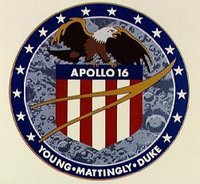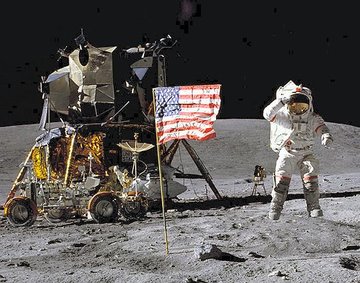Apollo 16
|
|
| Mission Insignia | |
|---|---|

| |
| Mission Statistics | |
| Mission Name: | Apollo 16 |
| Call Sign: | Command module: Casper Lunar module: Orion |
| Number of Crew: | 3 |
| Launch: | April 16, 1972 17:54:00 UTC Kennedy Space Center LC 39A |
| Lunar Landing: | April 21, 1972 02:23:35 UTC 8° 58' 22.84" S - 15° 30' 0.68" E Descartes Highlands |
| Lunar EVA length: | 1st: 7 h 11 min 2 s 2nd: 7 h 23 min 9 s 3rd: 5 h 40 min 3 s Total:20 h 14 min 14 s |
| CMP EVA: | 1 h 23 min 42 s |
| Lunar Surface Time: | 71 h 2 min 13 s |
| Lunar Sample Mass: | 95.71 kg |
| Splashdown: | April 27, 1972 19:45:05 UTC 0° 43' S - 156° 13' W |
| Duration: | 11 d 1 h 51 min 5 s |
| Number of Lunar Orbits: | 64 |
| Time in Lunar Orbit: | 125 h 49 min 32.59 s |
| Mass: | CSM 30,395 kg; LM 16,445 kg |
| Crew Picture | |
 Apollo 16 crew portrait (L-R: Mattingly, Young and Duke) | |
| Apollo 16 Crew | |
Apollo 16 was the tenth manned mission in the Apollo program and the fifth mission to land on the Moon.
| Contents |
Crew
- John W. Young (flew on Gemini 3, Gemini 10, Apollo 10, Apollo 16, STS-1, & STS-9), commander
- Thomas K. (Ken) Mattingly Jr. (flew on Apollo 16, STS-4, & STS-51-C), command module pilot
- Charles Duke Jr. (flew on Apollo 16), lunar module pilot
Backup crew
- Fred Haise, commander
- Stuart Roosa, command module pilot
- Edgar Mitchell, lunar module pilot
Support crew
Mission parameters
- Mass:
- Launch mass: 2,921,005 kg
- Total spacecraft: 46,782 kg
- CSM mass: 30,354 kg, of which CM was 5840 kg, SM 24,514 kg
- LM mass: 16,428 kg, of which ascent stage was 4971 kg, descent stage 11,457 kg
- Earth orbits: 3 before leaving for Moon, about one on return
- Lunar orbits: 64
- Perigee: 166.7 km
- Apogee: 176.0 km
- Inclination: 32.542°
- Period: 87.85 min
- Perilune: 107.6 km
- Apolune: 315.4 km
- Inclination: 168°
- Period: 120 min
- Landing Site: 8.97301° S - 15.50019° E (http://nssdc.gsfc.nasa.gov/planetary/lunar/lunar_sites.html) or
8° 58' 22.84" S - 15° 30' 0.68" E
LM - CSM docking
EVAs
- Young and Duke - EVA 1
- EVA 1 Start: April 21, 1972, 16:47:28 UTC
- EVA 1 End: April 21, 23:58:40 UTC
- Duration: 7 hours, 11 minutes, 02 seconds
- Young and Duke - EVA 2
- EVA 2 Start: April 22, 1972, 16:33:35 UTC
- EVA 2 End: April 22, 23:56:44 UTC
- Duration: 7 hours, 23 minutes, 09 seconds
- Young and Duke - EVA 3
- EVA 3 Start: April 23, 1972, 15:25:28 UTC
- EVA 3 End: April 23, 21:05:31 UTC
- Duration: 5 hours, 40 minutes, 03 seconds
- Mattingly - Transearth EVA 4
- EVA 4 Start: April 25, 1972, 20:33:46 UTC
- EVA 4 End: April 25, 21:57:28 UTC
- Duration: 1 hour, 23 minutes, 42 seconds
The splashdown point was 0 deg 43 min S, 156 deg 13 min W, 215 miles (350 km) southeast of Christmas Island and 5 km (3 mi) from the recovery ship USS Ticonderoga.
Mission highlights
Apollo_16_LM_Orion.jpg
A malfunction in a yaw gimbal servo loop in the main propulsion system of the CSM "Casper" caused concerns about firing the engine to adjust the CSM's lunar orbit, and nearly caused the Moon landing to be scrubbed. But it was decided that the malfunction presented little risk, and Young and Duke (who were already undocked, and flying "Orion" when the problem occurred) were permitted to land.
Young and Duke ultimately spent three days exploring the Descartes highland region, while Mattingly circled overhead in "Casper." What was thought to have been a region of volcanism turned out to be a region full of impact-formed rocks (breccias), based on the astronauts' discoveries. Their collection of returned specimens included an 25 pound (11 kg) chunk that was the largest single rock returned by the Apollo astronauts. The Apollo 16 astronauts also conducted performance tests with the lunar rover, at one time getting up to a top speed of 11 miles per hour (18 kilometers per hour).
Introduction
The crew members: John W. Young, commander; Ken Mattingly, command module pilot; and Charles Duke, lunar module pilot. It was a J-class mission, featuring a Lunar Rover. It brought back 94.7 kg of lunar samples. It included three lunar EVA: 7.2 hours, 7.4 hours, 5.7 hours and one trans-earth EVA of 1.4. This was only the second trans-earth EVA ever and was used to bring in film from exterior cameras and open an experiment on microbial survival.
The Apollo 16 subsatellite was launched from the CSM while it was in lunar orbit. The subsatellite carried out experiments on magnetic fields and solar particles. It was launched April 24, 1972 at 21:56:09 UTC and orbited the Moon for 34 days and 425 revolutions. It had a mass of 80 lb (36.3 kg) and consisted of a central cylinder and three 1.5 m booms.
Relics
The command module is currently at the U.S. Space & Rocket Center, in Huntsville, Alabama. The lunar module separated 24 April 1972 but a loss of attitude control rendered it out of control. It orbited the Moon for about a year. Its impact site on the Moon is unknown.
Media
See also
Reference
- NASA NSSDC Master Catalog (http://nssdc.gsfc.nasa.gov/nmc/sc-query.html)
- APOLLO BY THE NUMBERS: A Statistical Reference by Richard W. Orloff (NASA) (http://history.nasa.gov/SP-4029/Apollo_00a_Cover.htm)
- The Apollo Spacecraft: A Chronology (http://www.hq.nasa.gov/office/pao/History/SP-4009/cover.htm)
- Apollo Program Summary Report (http://history.nasa.gov/apsr/apsr.htm)
- Apollo 16 Characteristics - SP-4012 NASA HISTORICAL DATA BOOK (http://history.nasa.gov/SP-4012/vol3/table2.44.htm)
External links
- Apollo 16 entry in Encyclopedia Astronautica (http://www.astronautix.com/flights/apollo16.htm)
- U.S. Space & Rocket Center Museum (http://www.spacecamp.com/museum/) (location of Apollo 16 command module)
Template:Project Apolloaf:Apollo 16 da:Apollo 16 de:Apollo 16 et:Apollo 16 fr:Apollo 16 it:Apollo 16 hu:Apollo-16 nl:Apollo 16 pt:Apollo 16 fi:Apollo 16

